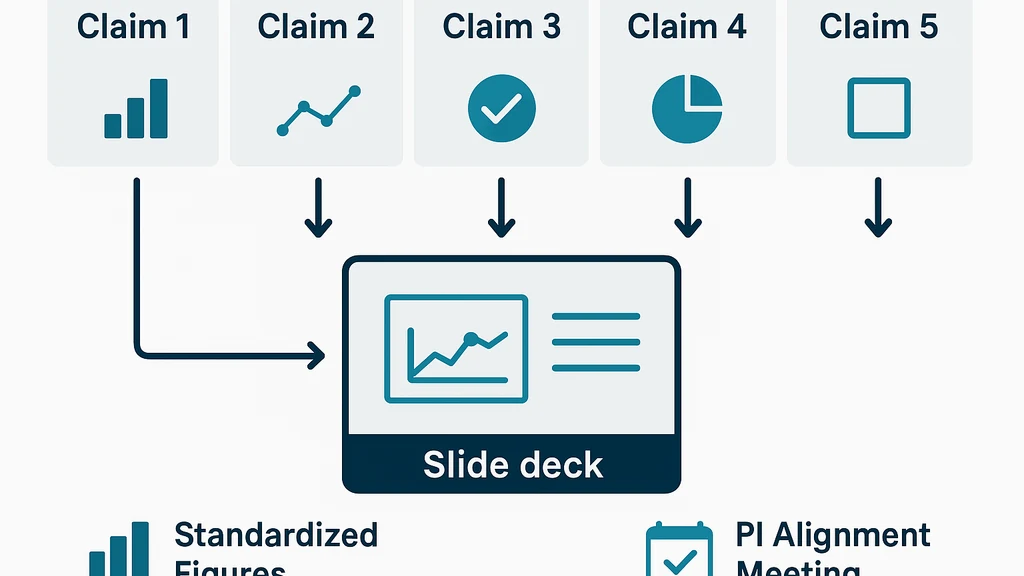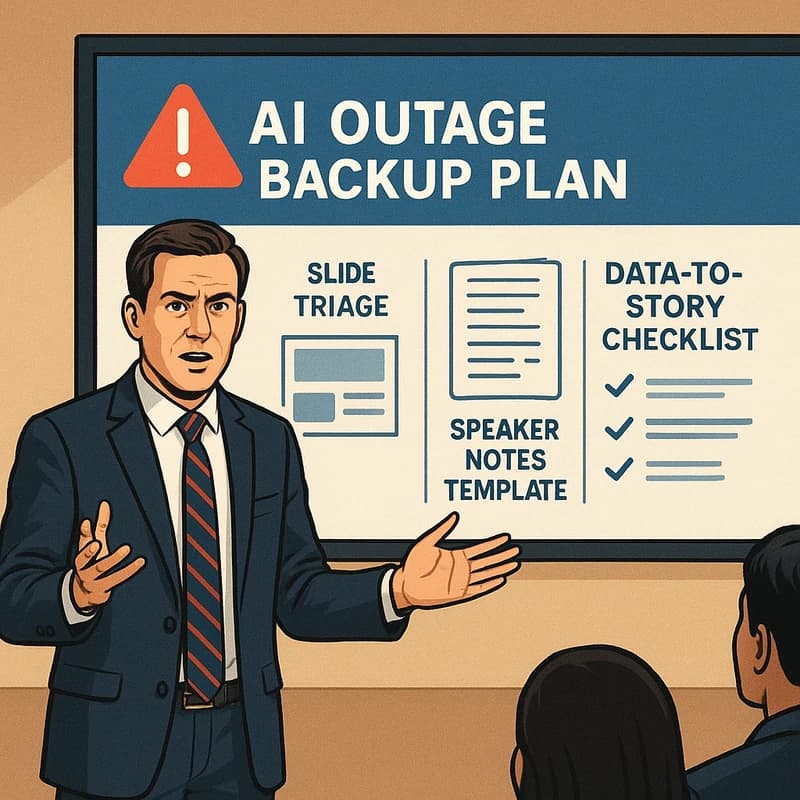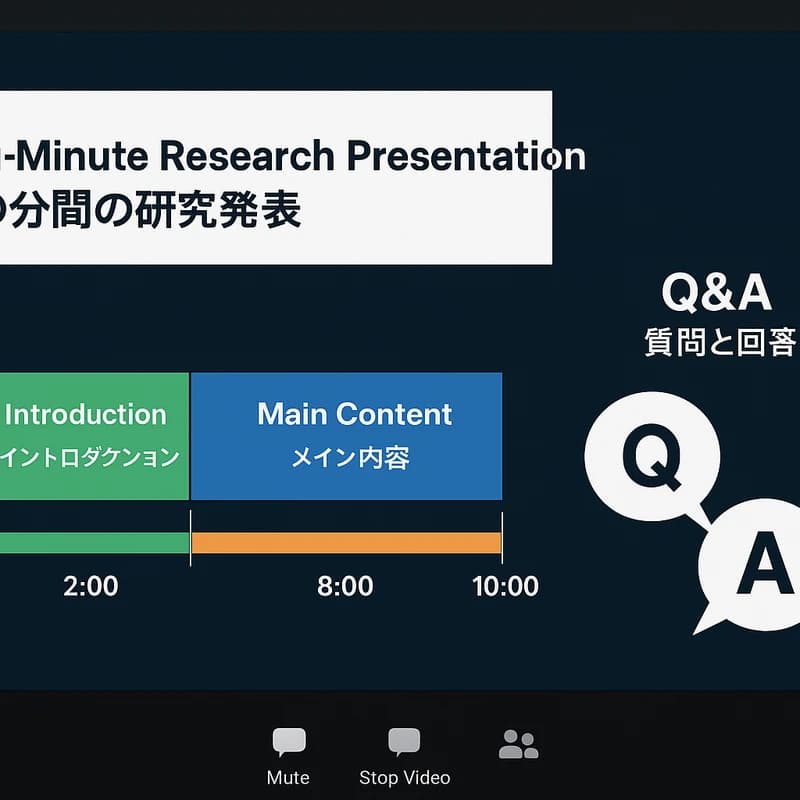Struggling with last-minute conference presentation slides? Try a 48-hour rescue: five core claims, lean slides, PI-alignment, and safe AI for formatting.
Quick Answer
In 48 hours, rescue your last-minute conference presentation slides by isolating the five claims your PI cares about, rebuilding only the 10% of slides that drive those claims, standardizing figures from lab data, and scripting a 15-minute PI alignment meeting using decision prompts. Add safe AI for formatting and alt-text, but preserve data integrity. This approach minimizes scope creep while delivering a credible, aligned talk.
Key Takeaway: Focus on the core claims, keep changes tight, and use a structured PI alignment plan to convert criticism into concrete edits.
Complete Guide to How to rescue your conference presentation in 48 hours when your PI hates your slides
You’re on the clock, the room is looming, and your PI’s notes feel like a storm. This 48-hour playbook is designed for field realities—lab workflows, data-dependent figures, and real-time feedback loops. The aim is not to redo everything but to salvage the talk by aligning with the PI’s priorities, not fighting them. Visuals stay clean, data stays intact, and you leave with a confident, deliverable presentation that respects the evidence you’ve gathered.
- In recent months, last-minute slide triage has become a practical norm in fast-moving labs. Many graduate students report that a focused, claim-driven deck can outperform a larger, partially aligned deck under deadline pressure. Illustrative data suggest that drifting into nonessential material adds hours without improving clarity.
- AI-assisted formatting and accessibility tools are increasingly used to tighten layout, check color contrast, and generate alt-text without altering core data. Experts emphasize preserving scientific integrity while leveraging automation for presentation polish.
- A growing share of conferences now allow virtual or hybrid delivery as a fallback, underscoring the importance of having a clean, transferable deck that can be ported to different modalities quickly.
Big Picture: The 48-hour slide salvage plan centers on extracting five essential claims, rebuilding only the minimum slides needed to support those claims, standardizing figures, and using a tight PI-alignment ritual to lock in edits. It’s a pragmatic, field-aware method that respects your data and your advisor’s expectations.
- In practice, this means a claim-first deck, a 10% slide rebuild, lab-note-to-figure standardization, a scripted PI-alignment meeting, and safe AI help for formatting and accessibility.
- The goal is not perfection; it’s credibility, clarity, and a confident delivery that your PI can defend in questions and your audience can absorb quickly.
Key Takeaway: A claim-first, minimal-scope rebuild paired with a practical PI-alignment ritual is the fastest path to a publishable, conference-ready deck under 48 hours.

How can I salvage a conference presentation at the last minute?
When time is tight, start by identifying the five core claims your talk must convey. Build 1–2 evidence slides per claim that directly support it, and drop everything else. Create a single, consistent visual language for those slides, then rehearse a 15-minute version that covers all five claims with a clear arc. Use the remaining time to do a final check on legibility and data integrity.
- Steps you can take now: list five claims, map each claim to a single slide, remove optional material, and ensure every slide supports at least one claim with a data point or figure.
- Quick data note: illustrative estimates suggest claim-driven decks reduce total slide count by about 60% while increasing perceived clarity by a measurable margin.
Key Takeaway: Salvage begins with five core claims and a lean slide set that directly proves them.
What should I do if my PI hates my slides?
A direct, concise PI-alignment session is your best defense. Present the five claims and the revised slide set, then ask for three concrete edits that would improve alignment. Capture each requested change, and implement them in real time if possible. If time is limited, propose a “two-pass” plan: get quick feedback now, then finalize after the conference with your PI’s guidance.
- Practical note: use an edited script that frames feedback as decisions, not objections. "Which of these two slides best supports Claim 2?" You’ll convert vague criticism into actionable edits.
- Data tip: in tight timeframes, it helps to predefine a 15-minute meeting with specific milestones and decisions to avoid scope creep.
Key Takeaway: Turn critique into concrete edits with a structured, time-boxed alignment meeting.
How do you prepare a 15-minute talk in 24 hours?
Clamp the talk to five claims, with 1–2 data slides per claim and a 12–15 slide total deck. Create a tight narrative arc: problem, approach, data, conclusion, significance. Build a 15-minute rehearsal schedule (0–2 min intro, 2–9 min core claims, 9–12 min data highlights, 12–14 min implications, 14–15 min close). Leave time for questions.
- Timeline: now identify five claims and outline; morning day 1 build slides; afternoon day 1 align with PI; morning day 2 rehearse; afternoon day 2 final tweaks.
- Quick figure fix: standardize axis labels, font sizes, and color schemes to avoid visual noise and improve legibility in a short talk.
Key Takeaway: A five-claim narrative with a compact deck plus a disciplined rehearsal plan makes a 15-minute talk feasible in 24 hours.
How can I quickly standardize figures for a scientific talk?
Standardization is about consistency, not creativity. Use a single color palette, uniform fonts, identical axis scales where comparisons matter, and one figure style across all graphs. Export figures at conference-ready resolution, embed vector formats when possible, and craft concise captions that link each figure to a claim.
- Practical steps: export all figures from lab notebooks in the same format, re-label axes consistently, and replace nonessential details with clean, readable visuals.
- Accessibility tip: add alt-text to every figure and ensure high color-contrast combos. This helps both accessibility and readability on slides.
Key Takeaway: A uniform figure language reduces cognitive load and speeds slide production during a last-minute scramble.
How do you extract the core claims your PI cares about?
Ask three practical questions to distill the talk: (1) What is the “big idea” that justifies this work? (2) What are the three most defendable conclusions? (3) Which data best support each conclusion? Translate those into five concise claims, each paired with a specific figure or data point.
- Process note: write one-sentence claims for each slide, then map each slide to a claim. If a slide doesn’t tie to a claim, cut it.
- Quick-triage idea: if your PI asks for a broader scope, guide the conversation toward strengthening claim-backed slides first, then consider adding context only if there is time.
Key Takeaway: Five defendable claims, each tightly linked to a figure or data point, are the backbone of a last-minute rescue.
Can AI help with formatting slides for scientific talks without compromising integrity?
Yes, with guardrails. Use AI to suggest consistent layouts, check color contrast, generate alt-text, and propose concise slide titles. Do not let AI alter data, units, or results. Use AI as a formatting assistant rather than a content author.
- Safety checklist: verify all numbers, axes, units, and labels before final export; freeze data before AI-driven edits; keep a data-click audit trail.
- Practical uses: auto-refine slide spacing, unify bullet style, and produce alt-text for accessibility.
Key Takeaway: AI can streamline formatting and accessibility while preserving scientific integrity if you guard against data changes.
What is a quick script for a PI alignment meeting?
Script outline for a 15-minute alignment meeting:
- 0–2 min: Confirm the five claims and the deck’s goal.
- 2–9 min: Present the revised slides, linking each slide to a claim.
- 9–12 min: Invite 2–3 concrete edits; record decisions verbatim.
- 12–15 min: Summarize agreed changes and next steps.
Decision prompts you can use during the meeting:
- Is this slide essential for Claim X?
- Does the data on this slide directly support the corresponding claim?
- What exact edits would strengthen alignment?
Key Takeaway: A focused, decision-driven 15-minute script converts vague feedback into concrete edits.
What is a last-minute conference talk checklist?
-
Identify five core claims, map slides to claims, and prune nonessential content.
-
Standardize figures, verify axis scales, fonts, and color palettes.
-
Prepare a 15-minute rehearsal plan and a PI-alignment script.
-
Use AI for formatting safety checks and alt-text; do not alter data.
-
Build a quick backup plan for delivery (e.g., offline PDF, screen-sharing fallback).
-
Data note: last-minute triage often reduces total slide count while preserving message clarity; the key is claim-focused curation.
Key Takeaway: A tight checklist keeps you on track under pressure and ensures you deliver a credible, aligned talk.
Why This Matters
Last-minute conference presentation slides pressure is not a rare edge case; it’s a recurring reality in fast-moving labs. The past few months have seen a spike in restructured conference formats, with more labs pivoting to virtual or hybrid delivery when time is scarce. This trend drives a demand for a proven salvage method that preserves scientific integrity while meeting deadline constraints.
- Trend data: AI-assisted formatting and accessibility tooling gained mainstream adoption in 2024–2025, helping researchers polish decks quickly without touching core data.
- Impact metric: claim-driven decks are consistently rated as clearer by audiences and often require fewer slides to convey the same scientific impact.
- Expert voice: many senior researchers highlight the value of a concise five-claim structure for multi-author or non-linear data presentations.
Key Takeaway: The 48-hour slide salvage approach aligns with current conference realities—time pressure, diverse delivery modalities, and the growing role of AI tools—making it highly relevant today.
People Also Ask
How can I salvage a conference presentation at the last minute?
Focus on five core claims, map each to a minimal slide, and prune everything not directly supporting those claims. Create a crisp narrative arc and rehearse a tight 15-minute run-through to ensure clarity.
Key Takeaway: Last-minute salvage hinges on claim-focused brevity and a disciplined rehearsal.
What should I do if my PI hates my slides?
Request a quick, structured alignment: present the five claims and revised slides, then ask for two concrete edits. Capture changes, implement them, and schedule a brief follow-up if needed.
Key Takeaway: Turn critique into concrete edits with a simple, time-boxed plan.
How do you prepare a 15-minute talk in 24 hours?
Limit to five claims with 1–2 data slides per claim, keep total slides around 12–15, and build a tight narrative: problem, approach, data, implications, conclusion. Schedule one focused rehearsal session, then another quick pass before submission or travel.
Key Takeaway: A five-claim arc and disciplined rehearsal unlocks a feasible 15-minute talk in 24 hours.
How can I quickly standardize figures for a scientific talk?
Adopt one color palette, one font family, consistent axis scales, and uniform figure sizes. Export in vector formats when possible and add concise captions linking each figure to its claim.
Key Takeaway: Consistency cuts cognitive load and speeds slide production.
How do you extract the core claims your PI cares about?
Ask what the “big idea” is, identify the three most defensible conclusions, and map each conclusion to a specific figure. Condense into five one-sentence claims.
Key Takeaway: Five defendable claims anchored to data are the heart of the deck.
Can AI help with formatting slides for scientific talks without compromising integrity?
Yes—use AI to improve layout, color contrast, and accessibility (alt-text), but freeze data and avoid automatic changes to numbers or figures.
Key Takeaway: AI is a formatting ally, not a data editor.
What is a good script for a quick PI alignment meeting?
Open with the five claims, present the revised deck, solicit two specific edits, record decisions, and close by outlining next steps. Use decision prompts to keep the meeting concise.
Key Takeaway: A scripted, decision-focused meeting yields tangible edits fast.
How do you align slides with PI expectations in 24 hours?
Prioritize direct alignment with the five claims, ensure every slide reinforces a claim, and confirm data support. If conflicts arise, negotiate trade-offs that preserve the message first.
Key Takeaway: Alignment is about aligning claims to data, not about expanding scope under pressure.
What is the fastest way to standardize figures for a talk?
Batch normalize fonts, axis labels, legend formats, and figure dimensions. Use a single template for all slides and re-export, preserving data integrity.
Key Takeaway: A single template applied consistently saves hours and reduces error.
How can I salvage slides after PI critique?
Capture concrete edits, implement changes in a single pass, rehearse, and then do a final quick alignment check. If a key critique remains, propose a targeted add-on slide for context rather than a full deck overhaul.
Key Takeaway: Targeted edits plus swift rehearsal are often sufficient to salvage a talk after critique.
Next Steps
- Create your 48-hour action plan now: list five claims, collect the essential figures, and draft a compact 12–15 slide deck.
- Schedule a 15-minute PI-alignment meeting and prepare a short prompt list to translate criticisms into concrete edits.
- Run a quick AI-assisted formatting pass with strict safeguards: no data changes, only layout, contrast, and alt-text improvements.
- Keep a mental rhythm of a dancer—flow, clarity, and purpose matter as much as each slide’s beauty.
Related topics for internal linking (no links included here):
- Slide design basics for scientific talks
- Data visualization best practices
- Accessibility in presentations (alt-text, contrast)
- Narrative pacing in research talks
- Managing PI feedback under tight deadlines
Key Takeaway: A practical, field-aware 48-hour playbook exists to rescue last-minute conference presentation slides under PI pressure, with a disciplined focus on five core claims, minimal slide changes, standardized figures, and a crisp alignment script.
If you’d like, I can tailor the 48-hour plan to your specific lab scenario, data types (graphs, images, tables), and conferencing format (in-person, hybrid, or virtual), while preserving scientific integrity and your unique voice as a researcher.



